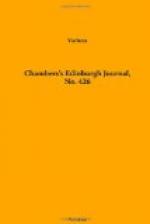of expensive habits. Now, this is the curious
thing in Robespierre’s history. Perhaps
there was a tinge of pride in his living a life of
indigence; but in fairness it is entitled to be called
an honest pride, when we consider that the means of
profusion were within his reach. On his arrival
in Paris, he procured a humble lodging in the Marais,
a populous district in the north-eastern faubourgs;
but it being represented to him some time afterwards,
that, as a public man, it was unsafe to expose himself
in a long walk daily to and from this obscure residence,
he removed to a house in the Rue St Honore, now marked
No. 396, opposite the Church of the Assumption.
Here he found a lodging with M. Duplay, a respectable
but humble cabinet-maker, who had become attached
to the principles of the Revolution; and here he was
joined by his brother, who played an inferior part
in public affairs, and is known in history as ’the
Younger Robespierre.’ The selection of this
dwelling seems to have fallen in with Robespierre’s
notions of economy; and it suited his limited patrimony,
which consisted of some rents irregularly paid by a
few small farmers of his property in Artois. These
ill-paid rents, with his salary as a representative,
are said to have supported three persons—himself,
his brother, and his sister; and so straitened was
he in circumstances, that he had to borrow occasionally
from his landlord. Even with all his pinching,
he did not make both ends meet. We have it on
authority, that at his death he was owing L.160; a
small debt to be incurred during a residence of five
years in Paris, by a person who figured as a leader
of parties; and the insignificance of this sum attests
his remarkable self-denial.
Lamartine’s account of the private life of Robespierre
in the house of the Duplays is exceedingly fascinating,
and we should suppose is founded on well-authorised
facts. The house of Duplay, he says, ’was
low, and in a court surrounded by sheds filled with
timber and plants, and had almost a rustic appearance.
It consisted of a parlour opening to the court, and
communicating with a sitting-room that looked into
a small garden. From the sitting-room a door
led into a small study, in which was a piano.
There was a winding-staircase to the first floor,
where the master of the house lived, and thence to
the apartment of Robespierre.’
Here, long acquaintance, a common table, and association
for several years, ’converted the hospitality
of Duplay into an attachment that became reciprocal.
The family of his landlord became a second family
to Robespierre, and while they adopted his opinions,
they neither lost the simplicity of their manners
nor neglected their religious observances. They
consisted of a father, mother, a son yet a youth,
and four daughters, the eldest of whom was twenty-five,
and the youngest eighteen. Familiar with the
father, filial with the mother, paternal with the
son, tender and almost brotherly with the young girls,




